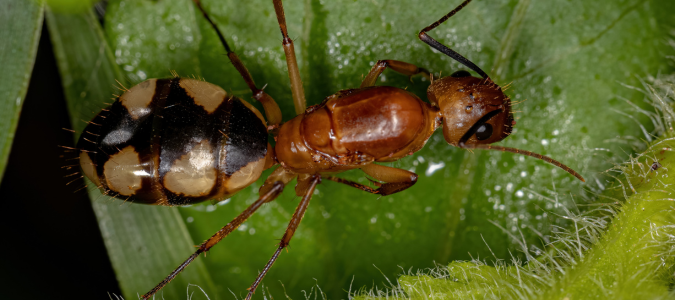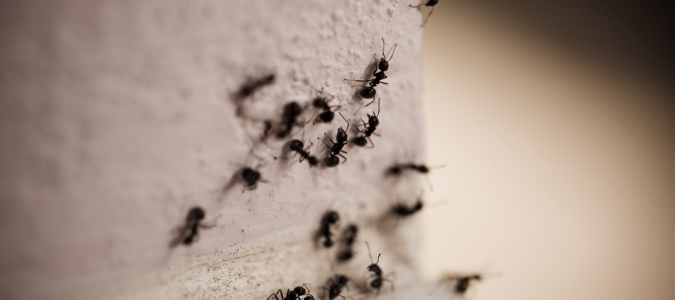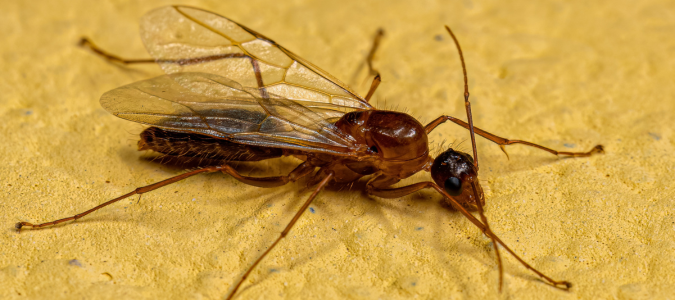Do you know how to tell a carpenter ant queen apart from other ants? While all ant species share several similarities, carpenter ant queens have a few distinctions that make them stand out.
Carpenter Ant Queen: Behavior and Identification
The easiest way to identify carpenter ant queens versus other carpenter ants is by their size. Carpenter ant queens can grow up to an inch in length, which is much longer than worker carpenter ants, which range from one-fourth to one-half of an inch.
Next, much like other ant species, carpenter ant queens can range in color. Most of them are reddish-brown but can be black, dark brown and yellow. Their color makes them hard to distinguish from other types of ants, so it’s important to use other factors to identify them.
For example, carpenter ant queens are known for having wings until they reach adulthood, which is a distinguishing factor. Female carpenter ants use their wings during their mating flight, when they mate in the air, to establish their own colony.
After successfully mating, carpenter ant queens shed their wings and start their new nest. It’s rare for them to leave their nest for the rest of their life.
One way to tell if you have carpenter ants in your home is by spotting their shed wings. The wings could’ve belonged to a carpenter queen ant or a reproductive male. Either way, it is a sign that a carpenter ant nest is nearby.
Carpenter ant wings are translucent in color and have prominent veins. They have two pairs of wings, and the front wings are larger than the back wings. If you see ant wings in your home, contact a pest control specialist to help you find the nest and remove the colony.
Carpenter Ant Queen Behavior
The primary job of the carpenter queen ant is to reproduce and establish a new carpenter ant colony. Once they successfully mate, carpenter queen ants rarely leave their nests. Carpenter ant workers, on the other hand, are responsible for gathering food and maintaining the nest.
As their name suggests, carpenter ant queens prefer establishing their nests in decaying wood. That could include dead branches, tree chambers, stumps and logs. They may also nest in building materials, such as wood from houses and sheds. However, the wood must be moist and decaying. Lastly, they may nest in wet piles of wood.
Carpenter ant queens live long lives, sometimes several years, and continue to lay eggs. Because of this, they can grow large colonies that branch off into new colonies.
Since carpenter ants reproduce rapidly, they can cause damage to wood structures. If you have carpenter ants around your home, contact a pest control expert to address the problem.
Can Carpenter Ants Survive Without a Queen?
Like many other ant and insect species, carpenter ant colonies live in a caste system. There are three castes: the queens, the swarmers and the workers. The queen reproduces and creates new nests, while the workers maintain the nest and forage for food.
Additionally, the worker ants also care for the larvae. The male swarmers reproduce with queens and then die shortly after mating.
Due to the caste structure, carpenter ant colonies cannot survive long without a queen. Firstly, carpenter ant queens can live for up to a few years, while worker ants only live for a few weeks. In fact, queens may even live for up to a decade, and during that time, they continue to reproduce to replenish the carpenter ant colony.
Carpenter ant queens can lay thousands of eggs in their lifetimes, and they are responsible for reproducing every worker ant in the colony.
Since the queen is the only ant responsible for reproduction in the entire colony, the rest of the colony would not last long without a queen. After a few weeks without a queen, most worker ants would die off, and no ants would be left to protect the larvae.
Worker ants are responsible for maintaining the nest, so once they start to die without a queen, the entire nest begins to fall apart. Without carpenter ant workers, there are no ants to care for the larvae, gather food or defend the nest against predators.
The carpenter ant queen’s job is to reproduce worker ants so that the nest can flourish and continue to grow. Both castes rely on each other to sustain the colony, but it is vital that each colony has a queen ant to produce new generations of workers. Without a carpenter ant queen, the colony cannot survive.
When to Work With a Pest Control Service to Control Carpenter Ants
Carpenter ants are known for causing damage to wood, which can leave a lasting impact on your trees. Additionally, when they reside in your home’s structure, they can cause damage that is costly to repair.
As soon as you spot the signs of a carpenter ant infestation, you should contact a professional pest control service. An expert will locate the nest, treat the colony and can implement prevention methods to deter carpenter ants from returning.
Pest control companies have the most effective solutions for dealing with various pests. It’s best to leave the job up to them instead of doing it yourself. The damage that carpenter ants can cause is not something to take lightly, so do not wait to work with the professionals.
Do Only Queen Carpenter Ants Have Wings?
Carpenter ant queens have wings, but they are not the only carpenter ants with wings. Reproductive carpenter ants, also known as swarmers or alates, also have wings. Between the months of March and July, male and female reproductive carpenter ants that have reached maturity leave their nests for a mating flight.
During flight, the carpenter ants reproduce and start new colonies. Male reproductive ants die shortly after mating, and female reproductive ants become queen ants. They shed their wings and begin their own nest, which they populate with worker ants and new reproductive ants that they produce.
This life cycle continues and repeats with new male and female reproductive ants each year. The other type of carpenter ants are worker ants, and they do not have wings. Since worker ants do not reproduce or go on a mating flight, they have no use for them. A pest control expert can help you control flying carpenter ants.
How to Deter Carpenter Ants
Carpenter ants are destructive pests; however, there are several steps that homeowners can take to deter them and avoid damage. First, eliminating their potential nesting spots can go a long way in deterring carpenter ants.
These ants are attracted to damp wood, so maintaining your home can help eliminate nesting spots. Fix all leaks and ensure proper drainage throughout your home. Additionally, use a humidifier in damp areas.
Next, clear any damp wood piles and debris from your property and remove moist tree stumps. If you have a wood pile, keep it away from the exterior of your home and store the wood off the ground. Additionally, cover the wood so that it doesn’t get wet when it rains.
Carpenter ants may try to migrate into your home, so it’s important to seal up all of their potential entry points. Inspect your house for cracks and holes along the foundation, walls, windows and doorways.
It’s also important to keep your home clean and avoid leaving out food for worker ants to find. Clean up spills and messes and keep all food items sealed in airtight containers.
Lastly, keep the tree branches around your home trimmed back to deter carpenter ants from using them as pathways to your house.
Work with a pest control service to deter carpenter ants for more peace of mind. An expert can inspect your home for weaknesses and advise you on the best prevention methods for your property.
Kick Out Carpenter Ants With Help From the Pros
A carpenter ant infestation is not something to take lightly, as these pests can cause damage to indoor and outdoor spaces. If you see signs of a carpenter ant colony on your property, contact a pest control specialist to deal with the problem.
With expert help, you can control a carpenter ant infestation and implement prevention methods to deter them from returning.
ABC Can Treat the Carpenter Ants on Your Property
If you’re dealing with carpenter ants, contact ABC Home & Commercial Services. Our professionals will create a custom ant control plan for your property. We even offer preventative pest control services so that any potential pest problems will be stopped in their tracks. They can also help you tell the difference between carpenter ants versus black ants.



